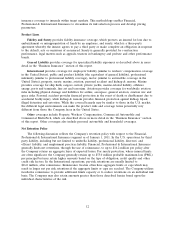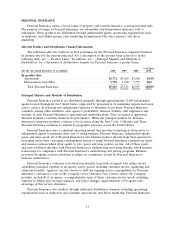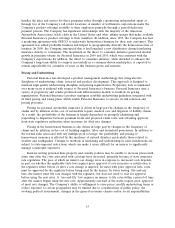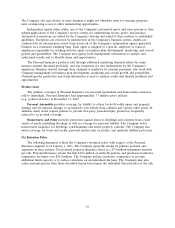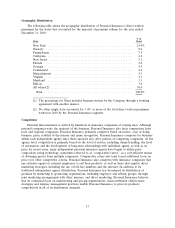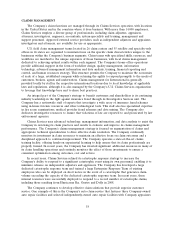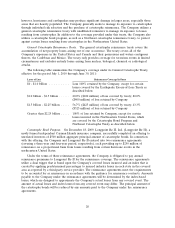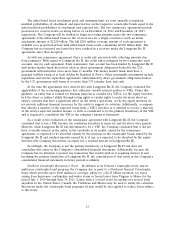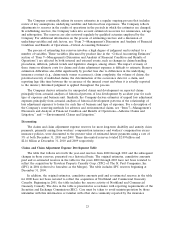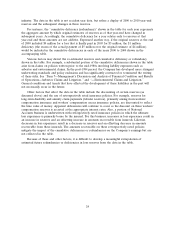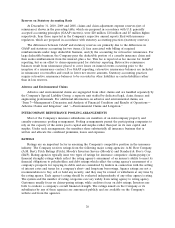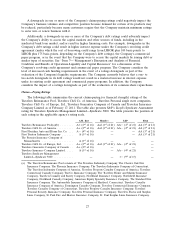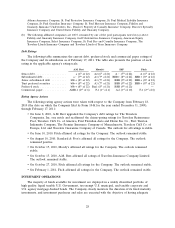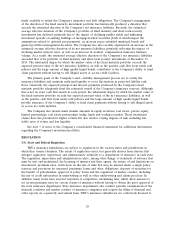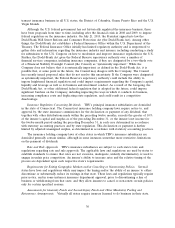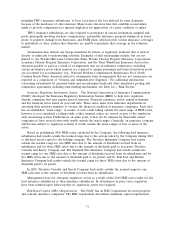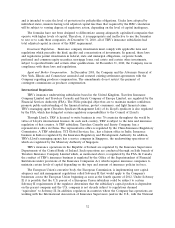Travelers 2010 Annual Report Download - page 34
Download and view the complete annual report
Please find page 34 of the 2010 Travelers annual report below. You can navigate through the pages in the report by either clicking on the pages listed below, or by using the keyword search tool below to find specific information within the annual report.Earthquake Excess-of-Loss Reinsurance Treaty—The Company has entered into an earthquake
excess-of-loss treaty that provides for up to $150 million of coverage, subject to a $125 million
retention, for earthquake losses incurred under policies written by the National Property business unit
in the Company’s Business Insurance segment for the period July 1, 2010 through June 30, 2011.
International Reinsurance Treaties. For business underwritten in Canada, the United Kingdom,
Republic of Ireland and in the Company’s operations at Lloyd’s, separate reinsurance protections are
purchased locally that have lower net retentions more commensurate with the size of the respective
local balance sheet. The Company conducts an ongoing review of its risk and catastrophe coverages
and makes changes as it deems appropriate.
Terrorism Risk Insurance Program. The Terrorism Risk Insurance Program (the Program) is a
Federal program administered by the Department of the Treasury that provides for a system of shared
public and private compensation for certain insured losses resulting from acts of terrorism or war
committed by or on behalf of a foreign interest. The Program has been authorized through 2014.
In order for a loss to be covered under the Program (subject losses), the loss must meet certain
aggregate industry loss minimums and must be the result of an event that is certified as an act of
terrorism by the U.S. Secretary of the Treasury, in concurrence with the Secretary of State and the
Attorney General of the United States. The annual aggregate industry loss minimum is $100 million
through 2014. The Program excludes from participation the following types of insurance: Federal crop
insurance, private mortgage insurance, financial guaranty insurance, medical malpractice insurance,
health or life insurance, flood insurance, reinsurance, commercial automobile, professional liability
(other than directors and officers’), surety, burglary and theft, and farm-owners multi-peril. In the case
of a war declared by Congress, only workers’ compensation losses are covered by the Program. All
commercial property and casualty insurers licensed in the United States are generally required to
participate in the Program. Under the Program, a participating insurer is entitled to be reimbursed by
the Federal Government for 85% of subject losses, after an insurer deductible, subject to an annual
cap.
The deductible for any calendar year is equal to 20% of the insurer’s direct earned premiums for
covered lines for the preceding calendar year. The Company’s estimated deductible under the Program
is $2.08 billion for 2011. The annual cap limits the amount of aggregate subject losses for all
participating insurers to $100 billion. Once subject losses have reached the $100 billion aggregate
during a program year, participating insurers will not be liable under the Program for additional
covered terrorism losses for that program year. The Company has had no terrorism-related losses since
the Program was established. Since the interpretation of this law is untested, there is substantial
uncertainty as to how they will be applied to specific circumstances. It is also possible that future
legislative action could change the Program. Further, given the unpredictable frequency and severity of
terrorism losses, as well as the limited terrorism coverage in the Company’s own reinsurance program,
future losses from acts of terrorism, particularly ‘‘unconventional’’ acts of terrorism involving nuclear,
biological, chemical or radiological events, could be material to the Company’s operating results,
financial position and/or liquidity in future periods. While the Company seeks to manage its exposure
to man-made catastrophic events involving conventional means, there can be no assurance that the
Company would have sufficient resources to respond to claims arising out of one or more man-made
catastrophic events involving so-called weapons of mass destruction, including nuclear, biological,
chemical or radiological means.
CLAIMS AND CLAIM ADJUSTMENT EXPENSE RESERVES
Claims and claim adjustment expense reserves (loss reserves) represent management’s estimate of
ultimate unpaid costs of losses and loss adjustment expenses for claims that have been reported and
claims that have been incurred but not yet reported.
22


